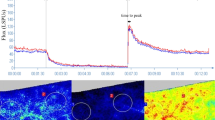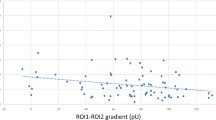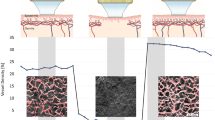Abstract
OBJECTIVE: The present study was undertaken to assess in pre- and postmenopausal women whether obesity influences cutaneous reactive hyperemia in the forearm.
DESIGN: Cross-sectional study.
SUBJECTS AND METHODS: Eight lean premenopausal (age 24.6±3.5 y, BMI=21.9±1.5 kg/m2, mean±1 s.d.), eight obese premenopausal (age 27.8±5.1 y, BMI=35.3±5.8 kg/m2), eight lean postmenopausal (age 56.1±8.3 y, BMI=20.2±2.2 kg/m2) and eight obese postmenopausal women (age 57.4±6.1 y, BMI=32.8±3 kg/m2) were included. Plasma glucose, insulin and lipid profile were determined in fasting state, and a glucose tolerance test was performed. The skin blood flow response to transient occlusion of the forearm circulation (reactive hyperemia, RH) was measured using a laser-Doppler imaging system.
RESULTS: Obese women had hyperinsulinemia, suggesting that they were insulin-resistant. The magnitude of the RH was similar in postmenopausal compared to premenopausal women. Obesity did not influence this microvascular response.
CONCLUSION: Obesity, which is known to be associated with impaired endothelial-dependent vasodilation in the skeletal musculature, has no effect on the RH of the forearm skin microcirculation.
This is a preview of subscription content, access via your institution
Access options
Subscribe to this journal
Receive 12 print issues and online access
$259.00 per year
only $21.58 per issue
Buy this article
- Purchase on Springer Link
- Instant access to full article PDF
Prices may be subject to local taxes which are calculated during checkout
Similar content being viewed by others
References
Eckel RH, Krauss RM . American Heart Association call to action: obesity as a major risk factor for coronary heart disease. AHA Nutrition Committee. Circulation 1998; 97: 2099–2100.
Reaven GM, Lithell H, Landsberg L . Hypertension and associated metabolic abnormalities — the role of insulin resistance and the sympathoadrenal system. N Engl J Med 1996; 334: 374–381.
Brook RD, Bard RL, Rubenfire M, Ridker PM, Rajagopalan S . Usefulness of visceral obesity (waist/hip ratio) in predicting vascular endothelial function in healthy overweight adults. Am J Cardiol 2001; 88: 1264–1269.
Hashimoto M, Akishita M, Eto M, Kozaki K, Ako J, Sugimoto N, Yoshizumi M, Toba K, Ouchi Y . The impairment of flow-mediated vasodilatation in obese men with visceral fat accumulation. Int J Obes Relat Metab Disord 1998; 22: 477–484.
Higashi Y, Sasaki S, Nakagawa K, Matsuura H, Chayama K, Oshima T . Effect of obesity on endothelium-dependent, nitric oxide-mediated vasodilation in normotensive individuals and patients with essential hypertension. Am J Hypertens 2001; 14: 1038–1045.
Steinberg HO, Chaker H, Leaming R, Johnson A, Brechtel G, Baron AD . Obesity/insulin resistance is associated with endothelial dysfunction. Implications for the syndrome of insulin resistance. J Clin Invest 1996; 97: 2601–2610.
Natali A, Buzzigoli G, Taddei S, Santoro D, Cerri M, Pedrinelli R, Ferrannini E . Effects of insulin on hemodynamics and metabolism in human forearm. Diabetes 1990; 39: 490–500.
Randin D, Vollenweider P, Tappy L, Jéquier E, Nicod P, Scherrer U . Effects of adrenergic and cholinergic blockade on insulin-induced stimulation of calf blood flow in humans. Am J Physiol 1994; 266: R809–R816.
Steinberg HO, Brechtel G, Johnson A, Fineberg N, Baron AD . Insulin-mediated skeletal muscle vasodilation is nitric oxide dependent. A novel action of insulin to increase nitric oxide release. J Clin Invest 1994; 94: 1172–1179.
Laakso M, Edelman SV, Brechtel G, Baron AD . Decreased effect of insulin to stimulate skeletal muscle blood flow in obese man. J Clin Invest 1990; 85: 1844–1852.
Kubli S, Waeber B, Dalle-Ave A . Reproducibility of laser-Doppler imaging of skin blood flow as a tool to assess endothelial function. J Cardiovasc Pharmacol 2000; 36: 640–648.
Morris SJ, Shore AC . Skin blood flow responses to the iontophoresis of acetylcholine and sodium nitroprusside in man: possible mechanisms. J Physiol (London) 1996; 496: 531–542.
Engelke KA, Halliwill JR, Proctor DN, Dietz NM, Joyner MJ . Contribution of nitric oxide and prostaglandins to reactive hyperemia in human forearm. J Appl Physiol 1996; 81: 1807–1814.
Arora S, Veves A, Caballaro AE, Smakowski P, LoGerfo FW . Estrogen improves endothelial function. J Vasc Surg 1998; 27: 1141–1146.
Durnin JVGA, Ramahan M . The assessment of the amount of fat in the human body from measurements of skinfold thickness. Br J Nutr 1967; 21: 681–689.
Anderson EA, Hoffman RP, Balon TW, Sinkey CA, Mark AL . Hyperinsulinemia produces both sympathetic neural activation and vasodilation in normal humans. J Clin Invest 1991; 87: 2246–2252.
Scherrer U, Randin D, Vollenweider P, Vollenweider L, Nicod P . Nitric oxide release accounts for insulin's vascular effects in humans. J Clin Invest 1994; 94: 2511–2515.
Montagnani M, Quon MJ . Insulin action in vascular endothelium: potential mechanisms linking insulin resistance with hypertension. Diabetes Obes Metab 2000; 2: 285–292.
Tack CJ, Ong MK, Lutterman JA, Smits P . Insulin-induced vasodilatation and endothelial function in obesity/insulin resistance. Effects of Troglitazone. Diabetologia 1998; 41: 569–576.
Agapitov AV, Correia ML, Sinkey CA, Dopp JM, Haynes WG . Impaired skeletal muscle and skin microcirculatory function in human obesity. J Hypertens 2002; 20: 1401–1405.
Title LM, Cummings PM, Giddens K, Nassar BA . Oral glucose loading acutely attenuates endothelium-dependent vasodilation in healthy adults without diabetes; an effect prevented by vitamins C and E. J Am Coll Cardiol 2000; 36: 2185–2191.
Pellaton C, Kubli S, Feihl F, Waeber B . Blunted vasodilatory responses in the cutaneous microcirculation of cigarette smokers. Am Heart J 2002; 144: 269–274.
Ferrannini E, Balkau B . Insulin: in search of a syndrome. Diabet Med 2002; 19: 724–729.
Bjorntorp P . Body fat distribution, insulin resistance, and metabolic diseases. Nutrition 1997; 13: 795–803.
Author information
Authors and Affiliations
Corresponding author
Rights and permissions
About this article
Cite this article
Seywert, AJ., Kubli, S., Giusti, V. et al. Similarity of cutaneous reactive hyperemia in the forearm of women with and without hyperinsulinemia. Int J Obes 28, 611–615 (2004). https://doi.org/10.1038/sj.ijo.0802587
Received:
Revised:
Accepted:
Published:
Issue Date:
DOI: https://doi.org/10.1038/sj.ijo.0802587



